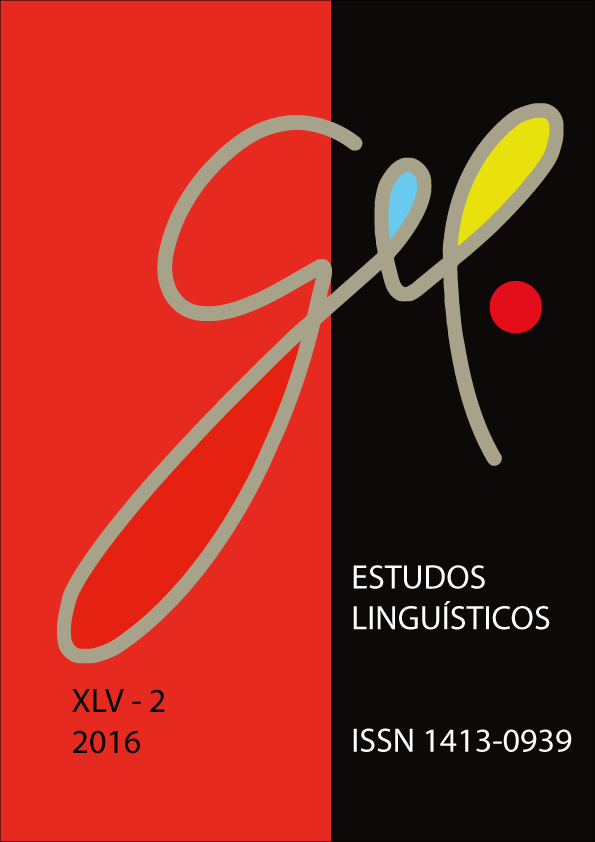Fictive Interactions as a Communicative Strategy in Speakers with Agrammatism: a Case Study
DOI:
https://doi.org/10.21165/el.v45i2.674Keywords:
fictive interactions, agrammatism, reduced speech, topic-comment structure, nonfiniteness.Abstract
This study is grounded in Enunciative-Discursive Neurolinguistics and intends to present the communicative potential of fictive interactions in syntactically reduced structures produced by two aphasic individuals with agrammatism. The data presented here are syntactically structured in the form of a topic-comment sentence and are non-finite. Pascual elaborated the concept of fictive interaction in 2002; since then, the author and colleagues have been working on the phenomenon in the sense that voices are brought into discourse and do not necessarily correspond to direct reported speech. In the data examined here, fictive interactions have a peculiar format: in OJ’s speech, a predominance of question and answer pairs can be observed, while in MS’ speech there is a greater recurrence of direct discourse framed in a scenario that demonstrates what he wishes to say.Downloads
References
BAKHTIN, M. O enunciado, a unidade da comunicação verbal. In: Estética da criação verbal. São Paulo: Martins Fontes, 1997. p. 289-327.
BÁNRÉTI, Z. Recursion in aphasia. Clinical Linguistics & Phonetics, 24 (11), p. 906-914, 2010.
BEEKE, S. R.; WILKINSON; R.; MAXIM, J. Grammar without sentence structure: A conversation analytic investigation of agrammatism. Aphasiology 21, (3/4), p. 256-282, 2007.
BELFORD, E. M. Topicalização de objetos e deslocamento de sujeitos na fala carioca: Um estudo sociolingüístico. 2006. 91 f. Dissertação (Mestrado em Letras) – Faculdade de Letras, Universidade Federal do Rio de Janeiro, Rio de Janeiro.
COUDRY, M. I. H. Diário de Narciso. Discurso e afasia: análise discursiva de interlocuções com afásicos. São Paulo: Martins Fontes, 1996. 205 p.
GUNDEL, J. K. Universals of topic-comment structure. In: HAMMOND M.; MORAVCZIK, E.; WIRTH, J. (org.). Studies in Syntactic Typology. Amsterdam: John Benjamins, 1988. p. 209-239.
HAARMANN, H. J.; KOLK, H. Syntactic priming in Broca's aphasics: evidence for slow activation. Aphasiology, 5, p. 247-263, 1991.
HEESCHEN, C.; KOLK, H. Agrammatism and paragrammatism. In: Aphasiology, 2, p. 299-302, 1988.
JACOBS, J. The dimensions of topic-comment. Linguistics, 39, p. 641-681, 2001.
KLEPPA, L. Estruturas de tópico-comentário na fala reduzida de um sujeito afásico. Estudos Linguísticos, 43 (2), p. 926-939, 2014.
KLEPPA, L. Estilo reduzido em sujeitos agramáticos, não-afásicos, telegramas e manchetes. Revista L@el em (Dis)curso, 2, p. 93-108, 2010.
KLEPPA, L. Fala reduzida em sujeitos afásicos e outros registros. Estudos Linguísticos, 38 (2), p. 249-258, 2009.
KLEPPA, L. Preposições ligadas a verbos na fala de uma criança em processo de aquisição de linguagem e de dois sujeitos agramáticos em processo de reconstrução de linguagem ou “Eu e você? Diferente. 2008. 163 f. Tese (Doutorado em Linguística) – Instituto de Estudos da Linguagem, Universidade Estadual de Campinas, Campinas.
KOLK, H. A time-based approach to agrammatic production. Brain and Language, 50, p. 282-304, 1995.
KOLK, H.; HEESCHEN, C. Adaptation symptoms and impairment symptoms in Broca’s aphasia. Aphasiology, 4, p. 221-232, 1990.
LI, C. N.; THOMPSON, S. A. Subject and topic: A new typology of language. In: LI, C. N. (org.). Subject and Topic. New York: Academic Press, Inc., 1976, p. 457-489.
MASLOVA, E. A.; BERNINI, G. Sentence topics in the languages of Europe and beyond. In: Pragmatic Organization of Discourse in the Languages of Europe. Berlin, New York: Mouton de Gruyter, 2006. p. 67-120.
MORATO, E. M. (Org.). Sobre as afasias e os afásicos. Campinas: Editora da UNICAMP, 2002. 62 p.
MORATO, E. M. Introdução In: MORATO, E. M. (Org.). A semiologia das afasias: perspectivas linguísticas. São Paulo: Cortez, 2010. p. 9-21.
NOVAES PINTO, R. C. Agramatismo: uma contribuição para o estudo do processamento normal da linguagem. 1992. 173 f. Dissertação (Mestrado em Linguística) – Instituto de Estudos da Linguagem, Universidade Estadual de Campinas, Campinas.
NOVAES PINTO, R. C. Cérebro, linguagem e funcionamento cognitivo na perspectiva sócio-histórico-cultural: inferências a partir do estudo das afasias. Letras de Hoje, v.47 (1), p. 55-64, 2012.
PASCUAL, E. Questions in legal monologues: Fictive interaction as argumentative strategy in a murder trial. Text & Talk, 26(3), p. 383-402, 2006a.
PASCUAL, E. Fictive interaction within the sentence: A communicative type of fictivity in grammar. Cognitive Linguistics, 17(2), p. 245-267, 2006b.
PASCUAL, E. Fictive Interaction: The Conversation Frame in Thought, Language, and Discourse. Amsterdam & Philadelphia: John Benjamins, 2014a. 453 p.
PASCUAL, E. The conversational mind: Fictive interaction in everyday, professional, and aphasic discourse. Palestra proferida no Departamento de Ciência Cognitiva, Hunan University, Changsha, China, 16 de maio de 2014b.
PASCUAL, E.; SANDLER, S. (org.). The Conversation Frame: Forms and Functions of Fictive Interaction. Amsterdam & Philadelphia: John Benjamins (no prelo).
PONTES, E. O tópico no português do Brasil. Campinas: Editora Pontes, 1987. 169 p.
WEBSTER, J.; FRANKLIN, S.; HOWARD, D. An Investigation of the Interaction between Thematic and Phrasal Structure in Nonfluent Agrammatic Subjetcs. Brain and Language, 78, p. 197-211, 2001.
WILKINSON, R. Projecting a reference in aphasic talk and normal talk. Discourse Processes, 46 (2-3), p. 206-225, 2009.
WILKINSON, R.; BEEKE, S.; MAXIM, J. Adapting to conversation: On the use of linguistic resources by speakers with fluent aphasia in the construction of turns at talk. In: GOODWIN, C. (Ed.). Conversation and brain damage. New York: Oxford University Press, p. 59-89, 2003.



